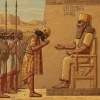
Cicero
The Horror of the Cross
Ancients
spoke of crucifixion with horror. Cicero's history reveals a
common loathing of death on the cross. It was the "extreme
and ultimate punishment of slaves" (servitutis extremum
summumque supplicium, Against Verres 2.5.169), the "cruelest
and most disgusting penalty." (crudelissimum taeterrimumque
supplicium, ibid. 2.5. 165.)
Josephus calls it "the most pitiable of deaths." (Jewish War
7:203.)
The Lord
had lived in Roman territory where crucifixion was all too
familiar. This extreme punishment was Rome's method of
subjugation, as Josephus' account of troubled Palestine
repeatedly demonstrates. When rebellion arose in Jerusalem
after the death of Herod the Great, the governor of Syria
marched his legions through Galilee to Jerusalem and ordered
2,000 rebels to the cross. (Antiquities 17:295.)
At the later threat of the Jewish War in A.D. 66, the
procurator Gessius Florus retaliated violently with
indiscriminate slaughter in Jerusalem's streets, the arrest
of many citizens, and the order that they be "first scourged
and then crucified." (Jewish War 2:306.) The climax of that
war was the savage siege of A.D. 70, when Jerusalem was
isolated by the Roman general Titus, later the next emperor.
Starvation forced hordes of the poorer classes to steal out
of their fortifications for food. In typical Roman terror
lactic, hundreds of these were made daily examples by being
tortured and then crucified in plain view of the city walls.
(Jewish War 5:449.)
When Palestine became Roman territory the cross was introduced as a form of punishment, more particularly for those who could not prove their Roman citizenship; later on it was reserved for thieves and malefactors.
The punishment of the cross was also regularly inflicted for crimes such as highway robbery and piracy, for public accusation of his master by a slave, for a vow made against his masters prosperity, and for sedition and tumult. According to Roman custom, the penalty of crucifixion was always preceded by scourging; after this preliminary punishment, the condemned person had to carry the cross, or at least the transverse beam of it, to the place of execution, exposed to the taunts and insults of the people.
On arrival at the place of execution the criminal on his cross was lifted up. Soon the sufferer, entirely naked, was bound to it with cords. He was then fastened with nails to the wood of the cross. Finally, a placard called the titulus bearing the name of the condemned man and his sentence, was placed at the top of the cross."
Cicero's historyRead The Bible
- 1599 Geneva Bible (GNV)
- 21st Century King James Version (KJ21)
- American Standard Version (ASV)
- Amplified Bible (AMP)
- Amplified Bible, Classic Edition (AMPC)
- Authorized (King James) Version (AKJV)
- BRG Bible (BRG)
- Christian Standard Bible (CSB)
- Common English Bible (CEB)
- Complete Jewish Bible (CJB)
- Contemporary English Version (CEV)
- Darby Translation (DARBY)
- Disciples’ Literal New Testament (DLNT)
- Douay-Rheims 1899 American Edition (DRA)
- Easy-to-Read Version (ERV)
- English Standard Version (ESV)
- English Standard Version Anglicised (ESVUK)
- Evangelical Heritage Version (EHV)
- Expanded Bible (EXB)
- GOD’S WORD Translation (GW)
- Good News Translation (GNT)
- Holman Christian Standard Bible (HCSB)
- International Children’s Bible (ICB)
- International Standard Version (ISV)
- J.B. Phillips New Testament (PHILLIPS)
- Jubilee Bible 2000 (JUB)
- King James Version (KJV)
- Lexham English Bible (LEB)
- Living Bible (TLB)
- Modern English Version (MEV)
- Mounce Reverse Interlinear New Testament (MOUNCE)
- Names of God Bible (NOG)
- New American Bible (Revised Edition) (NABRE)
- New American Standard Bible (NASB)
- New American Standard Bible 1995 (NASB1995)
- New Catholic Bible (NCB)
- New Century Version (NCV)
- New English Translation (NET)
- New International Reader's Version (NIRV)
- New International Version - UK (NIVUK)
- New International Version (NIV)
- New King James Version (NKJV)
- New Life Version (NLV)
- New Living Translation (NLT)
- New Matthew Bible (NMB)
- New Revised Standard Version (NRSV)
- New Revised Standard Version Catholic Edition (NRSVCE)
- New Revised Standard Version, Anglicised (NRSVA)
- New Revised Standard Version, Anglicised Catholic Edition (NRSVACE)
- New Testament for Everyone (NTE)
- Orthodox Jewish Bible (OJB)
- Revised Geneva Translation (RGT)
- Revised Standard Version (RSV)
- Revised Standard Version Catholic Edition (RSVCE)
- The Message (MSG)
- The Voice (VOICE)
- Tree of Life Version (TLV)
- World English Bible (WEB)
- Worldwide English (New Testament) (WE)
- Wycliffe Bible (WYC)
- Young's Literal Translation (YLT)
Table of Contents
Main Menu
- Ancient Assyrian Social Structure
- Ancient Babylonia
- Ancient Canaan During the Time of Joshua
- Ancient History Timeline
- Ancient Oil Lamps
- Antonia Fortress
- Archaeology of Ancient Assyria
- Assyria and Bible Prophecy
- Augustus Caesar
- Background Bible Study
- Bible
- Biblical Geography
- Fallen Empires - Archaeological Discoveries and the Bible
- First Century Jerusalem
- Glossary of Latin Words
- Herod Agrippa I
- Herod Antipas
- Herod the Great
- Herod's Temple
- High Priest's in New Testament Times
- Jewish Literature in New Testament Times
- Library collection
- Map of David's Kingdom
- Map of the Divided Kingdom - Israel and Judah
- Map of the Ministry of Jesus
- Matthew Henry Bible Commentary
- Messianic Prophecy
- Nero Caesar Emperor
- Online Bible Maps
- Paul's First Missionary Journey
- Paul's Second Missionary Journey
- Paul's Third Missionary Journey
- Pontius Pilate
- Questions About the Ancient World
- Tabernacle of Ancient Israel
- Tax Collectors in New Testament Times
- The Babylonian Captivity
- The Black Obelisk of Shalmaneser
- The Books of the New Testament
- The Court of the Gentiles
- The Court of the Women in the Temple
- The Destruction of Israel
- The Fall of Judah with Map
- The History Of Rome
- The Incredible Bible
- The Jewish Calendar in Ancient Hebrew History
- The Life of Jesus in Chronological Order
- The Life of Jesus in Harmony
- The Names of God
- The New Testament
- The Old Testament
- The Passion of the Christ
- The Pharisees
- The Sacred Year of Israel in New Testament Times
- The Samaritans
- The Scribes
Ancient Questions
- Why Do the Huldah Gates Appear Different in Ancient Replicas and Modern Photos?
- What Is the Origin of the Japanese and Chinese Peoples? A Biblical Perspective
- How did the ancient Greeks and Romans practice medicine and treat illnesses?
- What were the major contributions of ancient Babylon to mathematics and astronomy?
- How did the ancient Persians create and administer their vast empire?
- What were the cultural and artistic achievements of ancient India, particularly during the Gupta Empire?
- How did ancient civilizations like the Incas and Aztecs build their remarkable cities and structures?
- What were the major trade routes and trading practices of the ancient world?
- What was the role of slavery in ancient societies like Rome and Greece?
- How did the ancient Mayans develop their sophisticated calendar system?
Bible Study Questions
- Why Do Christians Celebrate Christmas?
- How Many Chapters Are There in the Bible?
- The Five Key Visions in the New Testament
- The 400-Year Prophecy: Unpacking Genesis 15 and the Journey of a People
- The Authorized (King James) Version (AKJV): Historical Significance, Translation Methodology, and Lasting Impact
- Exploring the English Standard Version (ESV): Its Aspects, Comparisons, Impact on Biblical Studies, and Church Use
- A Detailed Historical Analysis of Language Updates in the KJ21: Comparison with Other Versions
- A Detailed Historical Analysis of the American Standard Version (ASV): Comparison to the King James Version, Influence on Later Translations, and Evaluation of Strengths and Weaknesses
- A Detailed Historical Analysis of Amplifications in the Amplified Bible (AMP) and Its Comparison to Other Bible Translations
- Detailed Historical Analysis of the Amplified Bible Classic Edition (AMPC): Examples of Amplifications and Comparative Analysis with Other Bible Translations
About
Welcome to Free Bible: Unearthing the Past, Illuminating the Present! Step into a world where ancient history and biblical narratives intertwine, inviting you to explore the rich tapestry of human civilization.
Discover the captivating stories of forgotten empires, delve into the customs and cultures of our ancestors, and witness the remarkable findings unearthed by dedicated archaeologists.
Immerse yourself in a treasure trove of knowledge, where the past comes alive and illuminates our understanding of the present.
Join us on this extraordinary journey through time, where curiosity is rewarded and ancient mysteries await your exploration.
Recent posts
-

How to Wear a Cross Pendant as a Daily Reminder of Your Faith
Picture this: each morning, you grab a little piece of metal—cool to the touch—and slide it around your neck. It’s a cross pendant, nothing fanc... -

The Grimanis: A Family Dedicated to Public Health and Philanthropy
In the serene outskirts of London, the Grimani family stands as a beacon of dedication to public health and social responsibility. Led by Dr. John Leo... -

Jehu Bows Before Shalmaneser III: A Unique Depiction in Ancient Near Eastern Art
One of the most fascinating and historically significant reliefs from the ancient Near East is the depiction of Jehu, king of Israel, bowing before th... -

A Joyful Tradition: The History of the Jubilee in the Catholic Church
Every so often, the Catholic Church invites the faithful to celebrate a special time of grace and renewal known as a Jubilee. This long-standing tradi... -

Healthlion Medical Solutions and LionHeart Family Institute Publish Comprehensive Study on Physician-Owned Family Practices in the U.S.
Healthlion Medical Solutions and the LionHeart Family Institute have officially concluded their extensive 12-month research on the future of physician...